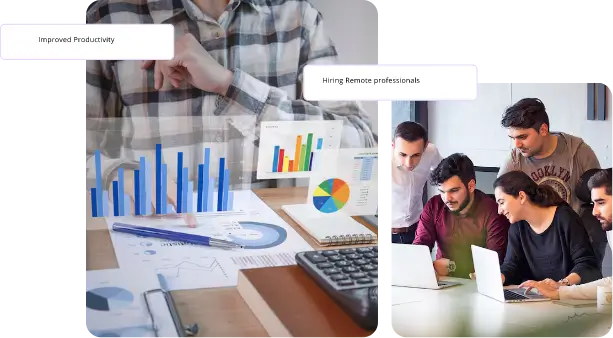Home / B / Biometric Attendance
What is Biometric Attendance?
Biometric attendance is a modern way for companies to track when employees arrive at and leave work. Instead of using traditional methods like signing a register, swiping an ID card, or entering a PIN, employees use their unique physical traits to clock in and out. These traits can include fingerprints, facial structure, or even patterns in the eye, such as an iris scan.
Each person has unique biometric features , which makes this system very secure. For example:
- Fingerprints – No two people have the same fingerprint.
- Facial recognition – The shape and features of a person’s face are unique.
- Iris scans – The colored part of the eye has a pattern that is different for everyone.
Because these features are different for every individual, it’s nearly impossible for someone else to pretend to be another person. This prevents common issues like “buddy punching,” where one employee checks in for another.
Biometric attendance systems are much more accurate than manual methods. They record the exact time an employee checks in or out, reducing errors and saving time for HR departments. These systems also help businesses keep better records, increase security, and improve overall efficiency in managing employee attendance.
In short, using a biometric attendance system helps companies monitor attendance more precisely and ensures that the right people are being recorded at the right times.
Why is Biometric Attendance Important?
Biometric attendance can be beneficial for companies in numerous ways:
- Stop Cheating at Work: Some workers might request a friend to punch in for them when they are not present. This is referred to as "buddy punching." Biometric systems prevent this since only the actual individual can check in with their fingerprint or face.
- Prevents Time Theft: Staff are paid for the time they work. If a person clocks on early or out late on paper but isn't present, that's theft of time. Biometric systems prevent this by registering actual time.
- Fewer Errors: People sometimes forget to sign at the right time or sign at all. A biometric system clocks the precise time automatically, so there are fewer chances of error.
- Fair For All: These systems ensure that all employees are given equal treatment. It promotes trust and equality within the workplace.
How Does Biometric Attendance Work?
Biometric attendance works by using a person’s unique physical features to record when they enter or leave the workplace. These features can include fingerprints, facial recognition, or iris patterns.
Here's a simple explanation of how it works:
- Enrollment: When an individual becomes a part of the company, the fingerprint, face, or iris scan of the person is captured and stored in the system.
- Daily Use: The employee will scan his finger or gaze at a camera when he comes to work and leaves work.
- Matching: The system verifies whether the scan corresponds to the stored data. If it does, the time is logged.
- Record Keeping: The system stores all records of attendance in a computer, which can be accessed by managers.
Using this system, managers can:
- Verify who arrived punctually or was late
- Compute payroll depending on actual working hours
- Print attendance reports
- Plan work shifts with ease
This eliminates the requirement for paper sheets or ID cards and makes everything precise and efficient.
Most Important Benefits of Biometric Attendance
- Accurate Records: Records exact arrival and departure times
- No Buddy Punching: Only the actual person can check in
- Saves Time: No writing or manual entry required
- Improves Security: Minimizes misuse and duplicate entries
- Easy to Integrate with Other Systems: Can be integrated with payroll and HR software
Certain Downsides to Biometric Attendance
Although biometric systems are extremely helpful, they also have some disadvantages:
- Privacy Concerns: Certain individuals might feel uneasy about sharing their personal information, such as fingerprints or facial scans
- Scanning Errors: Fingers being dirty, hands being wet, or even a change in appearance could lead to the system failing to identify an individual
- Expensive: The systems may be costly to install, particularly for small businesses
- Hygiene Concerns: Sharing fingerprint scanners can transfer germs
- Not for All: Individuals with some health conditions or handicaps might find it difficult to use the system
Examples of Biometric Attendance in Real Life
- Fingerprint Machines: Staff members touch a reader at the office entrance to sign in
- Facial Recognition Cameras: Cameras identify an employee's face automatically and record the time they arrives or departs
- Iris Scans in Secure Locations: Employees scan their eyes to gain entry and clock in at secure locations such as data centers
How Time Champ Empowers Biometric Attendance
Time Champ integrates with biometric hardware to provide businesses with a secure and precise means of monitoring attendance. Work hours are recorded automatically, paperwork is eliminated, time theft is prevented, and it all remains organized. Businesses save time and effort.
Related Terms You Should Know
- Attendance Tracking: Maintaining a record of the hours worked by employees
- Time Theft: Getting paid for hours that were not worked
- Buddy Punching: When an employee clocks in for another employee
- Work Schedules: The scheduled hours an employee is to work
- Leave Management: Monitoring and managing employee time-off requests

